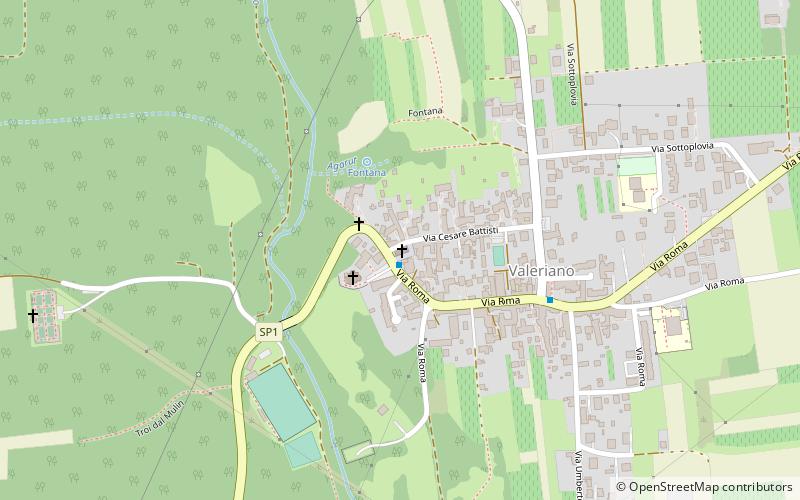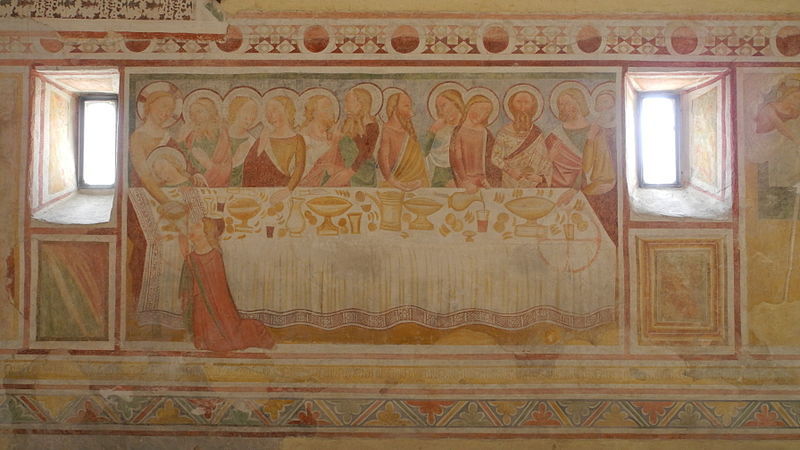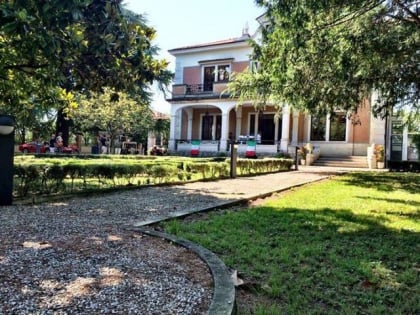Chiesa di Santa Maria dei Battuti, Pinzano al Tagliamento


Facts and practical information
The church of Santa Maria dei Battuti is a small house of worship erected by the confraternity of the Battuti di Valeriano around 1300. The confraternity gathered, as the name suggests, flagellants who promoted religious worship and engaged in works of charity. The structure of the church, which faces the square of Valerian, has a single nave with a barrel vault, but it has undergone several enlargements over the centuries. In the 14th century the nave was about 8.40 m long, and the apse was probably circular in shape. In the 16th century the overall length was almost doubled, the present polygonal apse was built with a three-sided back wall, and the structure was remodeled in several places. The small sacristy is probably later. The facade, which dates back to the late 15th century, has been called "a precious anthology collecting and illustrating the three golden centuries of painting": it is in fact a valuable work divided into four main scenes. To the right of the entrance portal is a grandiose St. Christopher, once attributed to Giovanni Antonio da Pordenone but most likely the work of Marco Tiussi. To the left of the portal, on the other hand, is a fresco by Pordenone depicting Saints Valerian, John the Baptist, and Stephen. Above the latter painting, again Pordenone frescoed the Magi in adoration. Finally, above the lunette of the architrave is a Madonna on the Throne, partially obliterated, surmounted by the Savorgnan coat of arms. All the original frescoes of the facade, dating from 1524, are kept inside the church, on the counterfacade, to protect them from the weather, while on the outside monochrome traces have been reproduced. The portal, dating from 1499, is the work of Giovanni Antonio Pilacorte.
Inside, the left wall contains a Nativity, a rather well-known work by Pordenone and dating from 1527. Other frescoes on this wall include: an Escape to Egypt, probably by a collaborator, and a 14th-century Christ in Glory. On the left wall of the nave, on the other hand, are a Last Supper, a Trinity, a Saint Nicholas, and a naturalistic scene: all 14th-century works, probably by the same hand. The original wooden altar is in the museum of Palazzo Ricchieri, Pordenone, and was replaced with a marble altar dating from 1527, but blessed only in 1964 because it had never been used before. The altarpiece by Gasparo Narvesa, painted in the late sixteenth century, depicts the Trinity with the Virgin and St. John the Baptist, and at the bottom Saints Valerian and Severus. As also reported in an inscription in the work, the altarpiece was made to fulfill a vow the painter made to St. Severus, his daughter having regained her sight by the saint's grace. In 1962 a long and painstaking restoration of the church began, which lasted ten years, but during the 1976 earthquake the vault collapsed and the building suffered severe damage. Following patient restoration work, which was finally completed in 1996, it is possible to admire the church in all its beauty. The church is also normally open to the public on weekdays.
Chiesa di Santa Maria dei Battuti – popular in the area (distance from the attraction)
Nearby attractions include: Biblioteca Guarneriana, Chiesa Parrocchiale Santa Maria Assunta, Villa Carnera, Church of Sant'Antonio Abate.
Frequently Asked Questions (FAQ)
When is Chiesa di Santa Maria dei Battuti open?
- Monday 10 am - 6 pm
- Tuesday 10 am - 6 pm
- Wednesday 10 am - 6 pm
- Thursday 10 am - 6 pm
- Friday 10 am - 6 pm
- Saturday 10 am - 6 pm
- Sunday 10 am - 6 pm











